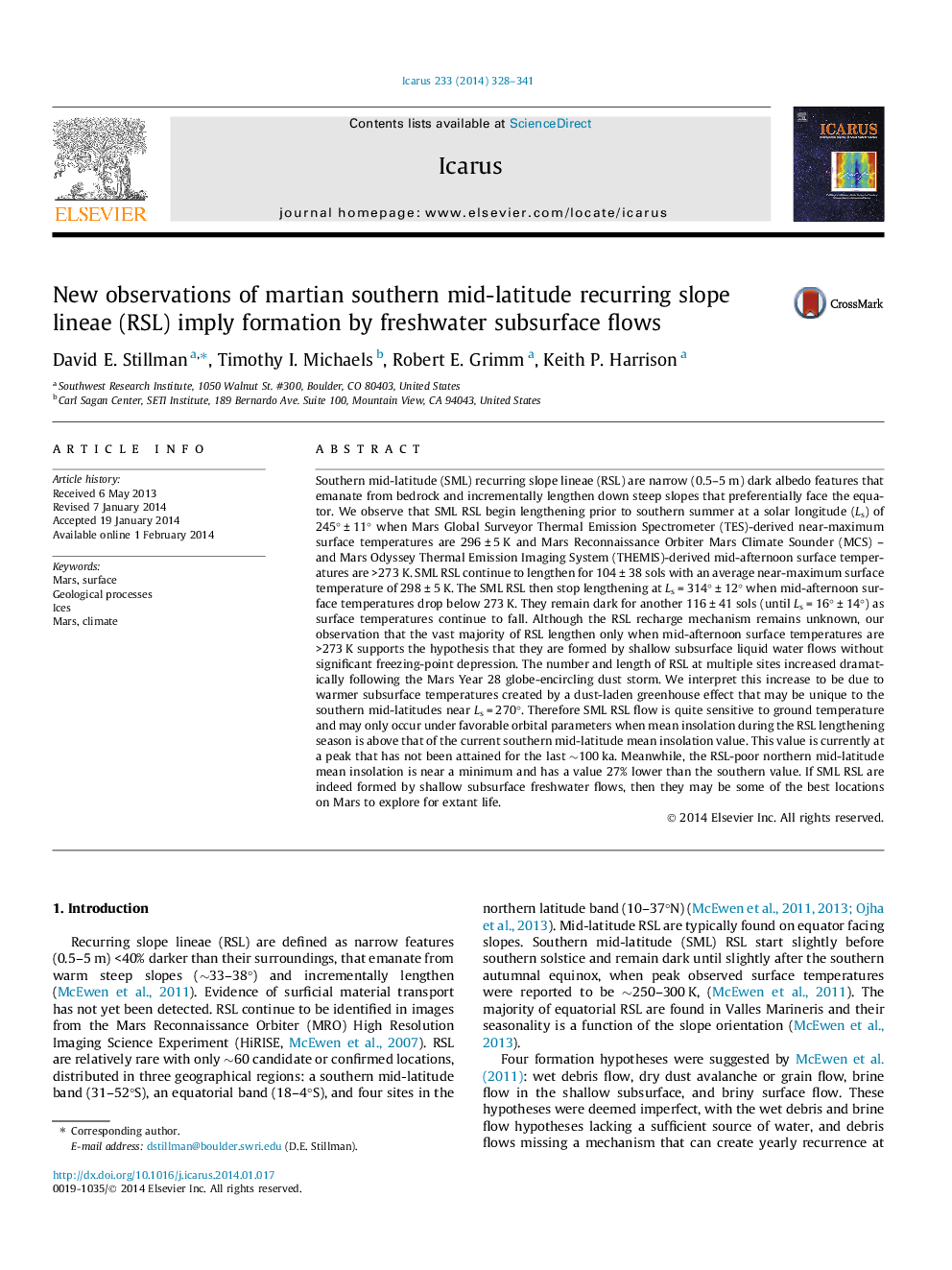| کد مقاله | کد نشریه | سال انتشار | مقاله انگلیسی | نسخه تمام متن |
|---|---|---|---|---|
| 8138406 | 1523557 | 2014 | 14 صفحه PDF | دانلود رایگان |
عنوان انگلیسی مقاله ISI
New observations of martian southern mid-latitude recurring slope lineae (RSL) imply formation by freshwater subsurface flows
دانلود مقاله + سفارش ترجمه
دانلود مقاله ISI انگلیسی
رایگان برای ایرانیان
کلمات کلیدی
موضوعات مرتبط
مهندسی و علوم پایه
علوم زمین و سیارات
علوم فضا و نجوم
پیش نمایش صفحه اول مقاله

چکیده انگلیسی
Southern mid-latitude (SML) recurring slope lineae (RSL) are narrow (0.5-5 m) dark albedo features that emanate from bedrock and incrementally lengthen down steep slopes that preferentially face the equator. We observe that SML RSL begin lengthening prior to southern summer at a solar longitude (Ls) of 245° ± 11° when Mars Global Surveyor Thermal Emission Spectrometer (TES)-derived near-maximum surface temperatures are 296 ± 5 K and Mars Reconnaissance Orbiter Mars Climate Sounder (MCS) - and Mars Odyssey Thermal Emission Imaging System (THEMIS)-derived mid-afternoon surface temperatures are >273 K. SML RSL continue to lengthen for 104 ± 38 sols with an average near-maximum surface temperature of 298 ± 5 K. The SML RSL then stop lengthening at Ls = 314° ± 12° when mid-afternoon surface temperatures drop below 273 K. They remain dark for another 116 ± 41 sols (until Ls = 16° ± 14°) as surface temperatures continue to fall. Although the RSL recharge mechanism remains unknown, our observation that the vast majority of RSL lengthen only when mid-afternoon surface temperatures are >273 K supports the hypothesis that they are formed by shallow subsurface liquid water flows without significant freezing-point depression. The number and length of RSL at multiple sites increased dramatically following the Mars Year 28 globe-encircling dust storm. We interpret this increase to be due to warmer subsurface temperatures created by a dust-laden greenhouse effect that may be unique to the southern mid-latitudes near Ls = 270°. Therefore SML RSL flow is quite sensitive to ground temperature and may only occur under favorable orbital parameters when mean insolation during the RSL lengthening season is above that of the current southern mid-latitude mean insolation value. This value is currently at a peak that has not been attained for the last â¼100 ka. Meanwhile, the RSL-poor northern mid-latitude mean insolation is near a minimum and has a value 27% lower than the southern value. If SML RSL are indeed formed by shallow subsurface freshwater flows, then they may be some of the best locations on Mars to explore for extant life.
ناشر
Database: Elsevier - ScienceDirect (ساینس دایرکت)
Journal: Icarus - Volume 233, 1 May 2014, Pages 328-341
Journal: Icarus - Volume 233, 1 May 2014, Pages 328-341
نویسندگان
David E. Stillman, Timothy I. Michaels, Robert E. Grimm, Keith P. Harrison,